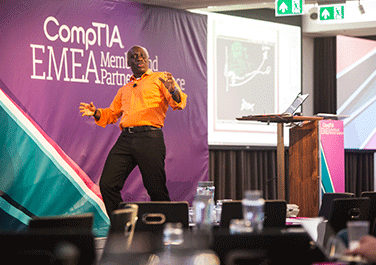 Events like the EMEA Member and Partner Conference give attendees a flurry of ideas and plans to implement in their businesses. But how do we turn new ideas into actual positive change?
Events like the EMEA Member and Partner Conference give attendees a flurry of ideas and plans to implement in their businesses. But how do we turn new ideas into actual positive change?
Eddie Obeng, organisational theorist, educator and author, wanted attendees to take a different approach to implementing ideas they picked up by achieving a better level of human understanding.
He said that when people look to the future and talk about future progress, they stick to abstract principles, talking about technology’s potential to help us travel better and faster, shop more effectively and work smarter. What they don’t do is consider how human behaviour will change. So, for example, we might hear about how autonomous cars will get us to meetings faster – when we should be considering whether meetings are really what we should be doing.
If we are to implement positive change, we need to engage people in it, not just technology. The problem is, human beings don’t like change. It scares them.
All of this is routed in our biology. Millions of years ago, humans either hunted or gathered. This was dangerous – we certainly weren’t the fastest runners or had the sharpest teeth, so often the hunters became the hunted. In a way, it’s a miracle that humans survived. People often say it was our ability to make tools, but no stick or stone would be a match for a sabre-toothed tiger. Or perhaps it was our ability to work in teams? But animals, like the sabre-toothed tiger, also hunted in packs.
No, what really made the difference was the part of our brain that identified change, and translated that into fear. Fear leads people to live completely in the moment, turn off rational thought, create adrenaline and optimise your physical response.
That was great for our ancestors. But fast-forward to today, and what most businesses seeking growth and improve productivity are after is rational thought. Fear isn’t helpful in a business setting. Unfortunately, our biology hasn’t caught up. Change still scares us.
So, if you want to really get people on board with change, and make a real difference, you need to present every new thing as if it’s not a new thing. This is, of course, particularly difficult for the tech industry, which is, by definition, excited by new developments. But it can be achieved by levelling the playing field, flattening hierarchy and switching from outcome to question mode. By bringing people into the conversation and asking their opinion on things, rather than springing change on them, you will put them in their best environment for building upon your idea and coming on the journey with you.
Digital is not about giving everyone an iPad. It’s about a fundamental shift. And a real shift is only possible when you think differently, allay people’s fears and bring them on the journey. When people are primed this way, the possibilities are endless.

